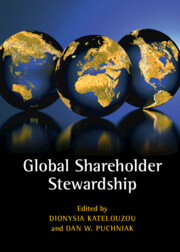Book contents
- Endorsements
- Global Shareholder Stewardship
- Global Shareholder Stewardship
- Copyright page
- Dedication
- Contents
- Figures
- Tables
- Contributors
- Foreword
- Acknowledgements
- Abbreviations
- Part I Foundations
- Part II Jurisdictions
- 4 Shareholder Stewardship in the Netherlands
- 5 Capitalist Stakeholders
- 6 Institutional Investor Stewardship in Italian Corporate Governance
- 7 The Danish Stewardship Code
- 8 Stewardship Norwegian-Style
- 9 Stewardship and Shareholder Engagement in Germany
- 10 The Japanese Stewardship Code
- 11 Korea’s Stewardship Code and the Rise of Shareholder Activism
- 12 The Assessment of Taiwan’s Shareholder Stewardship Codes
- 13 Stewardship in the Hong Kong International Financial Centre
- 14 Singapore’s Embrace of Shareholder Stewardship
- 15 Institutional Investor Stewardship in Malaysia
- 16 The Thai Institutional Investors Stewardship Code and Its Implementation
- 17 Shareholder Stewardship in India
- 18 Institutional Investors in China
- 19 Stewardship and Collective Action
- 20 Stewardship Principles in Canada
- 21 The Uncertain Stewardship Potential of Index Funds
- 22 Encouraging Sustainable Investment in South Africa
- 23 Stewardship in Kenya
- 24 The Brazilian Stewardship Framework
- Part III Comparisons
- Index
13 - Stewardship in the Hong Kong International Financial Centre
Adding ‘Responsible Owners’ to an Entrepreneurial Market
from Part II - Jurisdictions
Published online by Cambridge University Press: 28 April 2022
- Endorsements
- Global Shareholder Stewardship
- Global Shareholder Stewardship
- Copyright page
- Dedication
- Contents
- Figures
- Tables
- Contributors
- Foreword
- Acknowledgements
- Abbreviations
- Part I Foundations
- Part II Jurisdictions
- 4 Shareholder Stewardship in the Netherlands
- 5 Capitalist Stakeholders
- 6 Institutional Investor Stewardship in Italian Corporate Governance
- 7 The Danish Stewardship Code
- 8 Stewardship Norwegian-Style
- 9 Stewardship and Shareholder Engagement in Germany
- 10 The Japanese Stewardship Code
- 11 Korea’s Stewardship Code and the Rise of Shareholder Activism
- 12 The Assessment of Taiwan’s Shareholder Stewardship Codes
- 13 Stewardship in the Hong Kong International Financial Centre
- 14 Singapore’s Embrace of Shareholder Stewardship
- 15 Institutional Investor Stewardship in Malaysia
- 16 The Thai Institutional Investors Stewardship Code and Its Implementation
- 17 Shareholder Stewardship in India
- 18 Institutional Investors in China
- 19 Stewardship and Collective Action
- 20 Stewardship Principles in Canada
- 21 The Uncertain Stewardship Potential of Index Funds
- 22 Encouraging Sustainable Investment in South Africa
- 23 Stewardship in Kenya
- 24 The Brazilian Stewardship Framework
- Part III Comparisons
- Index
Summary
Hong Kong’s Principles of Responsible Ownership offer a telling example of what it means to be an international financial centre (IFC) in twenty-first-century Asia. The point of this stewardship code is to nudge institutional investors towards responsible voice and away from careless action and exit. This meets problems seen nearly a century ago by Berle and Means, and perhaps also displayed by aggressive activist shareholders in the 2010s. However, none of these motivational maladies are real for Hong Kong, where listed companies tend to be controlled by ‘entrepreneurial’ owners – families or very large holding companies. Such owners are active, informed and long-term-oriented, three adjectives associated with responsible ownership. Thus, a stewardship code fits Hong Kong poorly but for the fact that it is an IFC. The business of an IFC is to attract capital and listings from the entire world. The business model demands use of globally popular standards, even if poorly matched to local needs. This chapter examines how the signal sent by HK stewardship to London or New York financial institutions is more important than its real impact on market behaviour in Hong Kong.
- Type
- Chapter
- Information
- Global Shareholder Stewardship , pp. 284 - 296Publisher: Cambridge University PressPrint publication year: 2022



